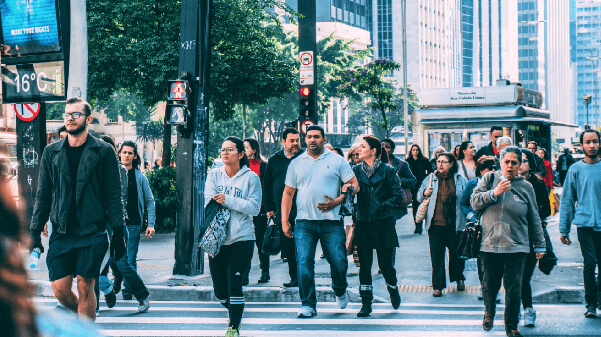“Cityzen” participation and the challenges of top-down design

By Toby Bennett | 21/05/19 10:30
4 min read
 Photo by Kaique Rocha, Courtesy of www.pexel.com
Photo by Kaique Rocha, Courtesy of www.pexel.com
As we know – cities are facing a crisis, a crisis of capacity. Rapid urbanisation and a growing global population will put a huge strain on both our social and civic infrastructure. I am going to try to unpack the reasons for this and potential solutions to what is an increasingly ubiquitous problem. Spoiler alert – participation is key.
Let’s start with the problem – the way Western cities are designed is often shockingly top-down. They’re made by technical experts who can design the most brilliant of architectural feats but whose hands and talent are frequently bound by harsh commercial realities within that city, or that place. People are not identical, nor should cities be and good design is not created overnight. People will navigate your newly constructed building in ways you’ve not thought of, but you can’t then easily remould the built environment. Second chances won't come round for decades, a mistake is an unforgiving monument to misjudgement. Therefore, you have to include people at the idea stage – you need the ideas of the collective to inform the construction of collective places. Users of the built environment must have their voice alongside the visionaries, entrepreneurs and technicians who develop it.
Does the governance of our society enable this collaborative effort?
Much of our democracy is underpinned by decision-making that takes into account a variety of perspectives before alighting upon common themes. Processes reach a mean-most view that reflects the most balanced, and therefore you’d hope correct, standpoint. You can see this in the judiciary and in political processes– two of the sacrosanct pillars of modern western civilisation.
As cities are inherently interconnected places – people gravitate to them for that very reason – you would imagine this collaboration would be inevitable, but for some reason with all of their connectivity they lack participation. People are attracted to the interconnectedness but rarely engage with how their cities are built, how they function, or how decisions are made about the shared fabric of our communities. I find this is extraordinary, given how the built environment impacts on daily lives.
As cities are inherently interconnected places – people gravitate to them for that very reason – you would imagine this collaboration would be inevitable, but for some reason with all of their connectivity they lack participation. People are attracted to the interconnectedness but rarely engage with how their cities are built, how they function, or how decisions are made about the shared fabric of our communities. I find this is extraordinary, given how the built environment impacts on daily lives.
Are people simply unwilling to contribute to how civic infrastructure is built? It’s not that people don’t care – we see on a daily basis through mediums like Twitter or Facebook that citizens want places and transport that work for them. You can see it from anything like “Bank Station is like a labyrinth, why do I change there?” to “The Central Line is like a salty sauna today. See it, say it, sort it out TFL”. We see socially-charged chatter about skyscrapers, rebuked Garden Bridges, and poorly-built estates. These aren’t meaningless mutterings, they’re echoes of people’s civic experience.
We lack the participation needed to affect the way the built environment is created. At the moment you’ll see a few hundred people engaged in consultation on planning or civic change in their area. We know from our work at Commonplace that this number can be raised ten-fold and more if the tools are credible and available. Typically we engage a tenth of the intellectual, creative, and idiosyncratic resource of our communities and citizens. Thousands, rather than hundreds, of voices would dramatically amplify the benefits of consultation.
But if so many people care, why do so few engage? How do we affect change? The answers, I believe, sit on three pillars of thinking –. policy, culture, and process.
First: Policy around consultation is archaic to the extent that it’s almost inaccessible to those who even work in the sector. Culture change has been impressively immovable for more than my lifetime. There needs to be top-down support for a bottom-up way of doing things. As it stands consultation is statutory but has become box-ticking in its nature. The benefits of asking opinion have been forgotten. Policy needs to reflect the importance of consulting communities, not just the necessity of it. There is a difference between hearing and listening. The good news is that the policy is changing – but it’s moving forward at a glacial speed, compared to urban and technological change.
Second: the culture of accessibility must change. People need to feel effective, and people need to easily access the ability to affect. It’s not enough to say that voices can be heard and to house them in town halls, it’s not enough that planning applications and Local Plans are publicly accessible if the language isn’t. People need to see a dialogue, they need to hear other voices to feel their own is heard. People need to feel empowered. Amplifying the voices of our communities would engender cultural change. Changing policy, language and means, can create a momentum that genuinely and dramatically improves how we make cities.
Third, we need new processes. How do we adapt what is a 19th and 20th Century process to the 21st? The technology exists to engage very large numbers of people who might not otherwise. I know because I’ve helped to build some of it and work with others who do. But a major question remains around adoption of the technology – the integration of technology into existing processes and structures. The technology is becoming best practice – and is seen by most as such – but now the process of adopting and implementing it needs to be fully mainstreamed.
There are ways of meeting the challenge that unprecedented urbanisation poses to our social and civic infrastructure. Technology is a big part of the answer and the planning sector is taking significant strides. PropTech and CivicTech are evolving rapidly. More good news is that the policy is being reviewed – the Raynsford Review (TCPA November 2018) and most recent National Planning Policy Framework (MHCLG, February 2019) are examples of that in action.
The final point, culture – I’m fairly positive that many people want to have a voice in decisions. I think you can see it on Social media with local Twitter hashtags and Facebook groups dedicated to places or communities. You see it in campaigning for and against high-profile projects. I can even tell when I speak to people about what I do – there is a popular interest in how we shape our cities.
Channelling that by making it really easy for people to get involved would harness a lot of untapped resource – the creativity, uniqueness, and local knowledge of people and communities.If we’re able to do that then we’ll be able to build cities that work for everyone whilst riding the benefits of urbanisation.
.png)